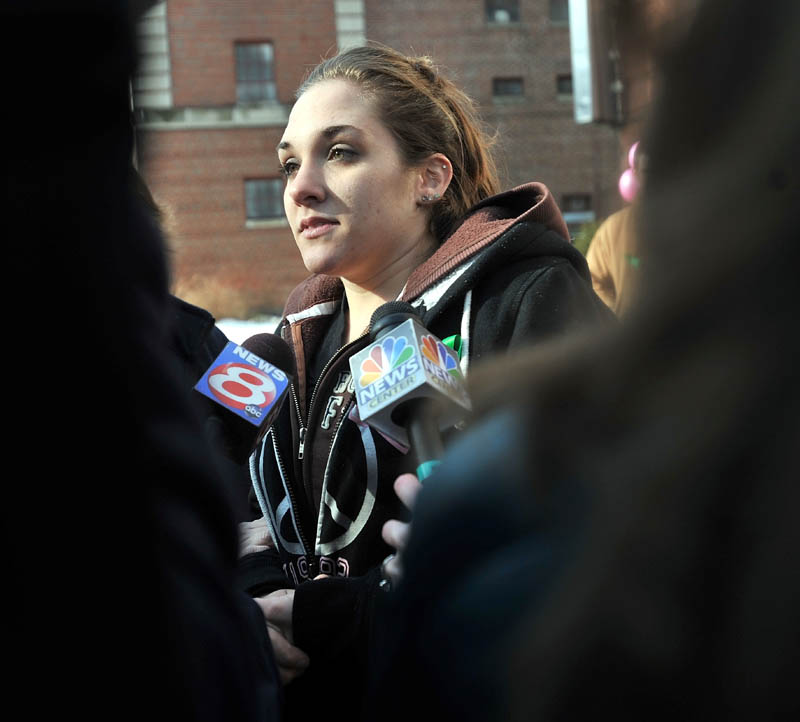WATERVILLE — They keep returning to the water, searching for signs.
Messalonskee Stream, which feeds into the swift-moving Kennebec River, is within walking distance of 29 Violette Ave., the home where 20-month-old Ayla Reynolds was last seen, one year ago.
The water has never been linked directly to the girl’s unexplained disappearance, but investigators keep going back there.
They were there in January a few weeks after she vanished, when the water was ice cold. They were there in April, when they reportedly found items connected to Ayla, although they wouldn’t say what those were.
Detectives returned in July, when the water was warm enough to allow divers to explore the depths and again in October, when the waters had been lowered for dam maintenance.
Still, the largest missing persons case in state history remains unsolved, despite intense interest and a slew of competing conspiracy theories. Police seem to be no closer to finding Ayla than they were a year ago.
The toddler’s parents have endured the most scrutiny, some of it fueled by each against the other. He still blames her. She still suspects him.
Justin DiPietro has mostly disappeared from the public spotlight. Trista Reynolds has been more visible. She said recently that she’s frustrated with the lack of movement in the case. If police believe the water holds clues to her daughter’s disappearance, they aren’t sharing that with Reynolds.
“We cannot let ourselves become frustrated,” Waterville Police Chief Joseph Massey said at a press conference Friday. “We need to turn frustration into determination and commitment to moving this case forward, and that’s what we’re going to do.”
Police used the anniversary of the girl’s disappearance to provide an update on the case and answer questions from reporters. No new details were offered, other than the fact that they have reopened their lines of communication with DiPietro and his family.
As the case has dragged on, separating truth from speculation has become difficult. Numerous websites devoted to the case offer divergent stories.
Supporters have organized several vigils to remind the public Ayla is still missing, the latest tonight in Waterville.
In May, after police said out loud what most already feared — that the girl was almost certainly dead — the focus started to shift toward finding her body.
The night Ayla disappeared
Reynolds and DiPietro were never really a couple.
“I guess you could say we were friends who had a child together,” she said.
It didn’t take long for the relationship between them to go bad.
When Reynolds gave birth to Ayla on April 4, 2010, DiPietro was not in the delivery room. In fact, he denied that she was his daughter until months later, after a paternity test. He saw Ayla only a handful of times before October 2011.
When Reynolds went into rehab for substance abuse, she needed someone to care for Ayla while she got clean. The toddler went to live with DiPietro in his mother’s home on Violette Avenue.
Reynolds said when she got out, DiPietro refused to give Ayla back. Then, she said, he sent her text messages indicating that he was worried someone might take Ayla.
She said she talked to her daughter on the phone on Dec. 8. When she tried calling after that, DiPietro made excuses for why Ayla couldn’t come to the phone.
Reynolds filed for sole custody of Ayla on Dec. 15, 2011, in Cumberland County District Court, saying she was concerned about her daughter’s wellbeing.
DiPietro reported the girl missing on the morning of Dec. 17.
He told police he put her to bed about 8 p.m. on Dec. 16. When he checked on her in the morning, more than 12 hours later, she was gone.
Two other adults who were in the house that night, DiPietro’s girlfriend, Courtney Roberts and his sister, Elisha DiPietro, both told police they don’t know what happened to Ayla.
DiPietro cooperated with police at first. He released statements to the media, saying that he didn’t know what happened and he was not responsible for her death or disappearance. But as more questions arose and more suspicion centered on him, he stopped talking.
Police later announced that they didn’t believe the child wandered away on her own, nor did they believe she was abducted.
Police also said they believed DiPietro and the other adults in the house “have not told us the whole story.”
On Friday, Department of Public Safety spokesman Steve McCausland said investigators had resumed talks with DiPietro and his family for the first time in months. McCausland called it as a positive step.
Multiple attempts to reach DiPietro for this story through friends and relatives were unsuccessful. Messages left for Courtney Roberts were not returned. She has yet to speak to the media.
Elisha DiPietro, who still lives in the home on Violette Avenue, refused to speak to a reporter this week.
There is a small sign on the front lawn, displaying Ayla’s name, picture and the word “Missing.” Another sign read, “No Trespassing.”
Doubts and accusations
Trista Reynolds said she and her family began to doubt DiPietro’s version of events early in the investigation.
More of what trickled out only fueled the suspicion against DiPietro.
Police confirmed that he bought a $25,000 life insurance policy against Ayla less than two months before she vanished. Ayla’s blood was found in the basement of the Waterville home. Police would not reveal how much, but said it was “more than a cupful.”
DiPietro told a Morning Sentinel reporter that he “smoked” a polygraph test police had him take. Reynolds said he failed. Police haven’t revealed the results.
McCausland later said that DiPietro cut off communication with detectives, a claim DiPietro disputed in a March 30 story in the Morning Sentinel. “(They) have my phone number,” he said at the time. “They know where I live.”
Police also seized DiPietro’s truck and Roberts’ car early on and searched both for evidence. They haven’t said whether anything was found.
Reynolds blames herself but blames him more for what happened to their daughter. His job was to protect Ayla, she said. He failed.
“I hate him so much, but then at the same time I want to, like, see him,” she said. “I feel like if I see him, I’m going to see Ayla because she’s him.”
Clint Van Zandt, a former FBI criminal profiler and TV personality who has followed the case since the beginning but is not involved in the investigation, said he believes whatever happened to Ayla took place inside the Waterville home. He said at least one of the people who was there knows something they haven’t told police.
“People have a right to remain silent,” Van Zandt said last week by telephone. “Until law enforcement officials can provide forensic evidence, they can’t force anyone to talk.”
Police have hinted at their suspicions about DePietro but saying they think he has held back information, but they have never named him — or anyone — a suspect, or even a person of interest.
Speculation and contradiction
In the beginning, it was a missing persons case. Then, it was classified as an abduction. Then the foul play declaration. Now, it has once again been classified a missing persons case, the third unsolved missing child investigation in Maine in the last 40 years.
A week after the toddler’s disappearance, Maine’s top two homicide investigators, Andrew Benson and William Stokes from the attorney general’s office, were seen at the house.
Stokes said the case has been enormously complicated and that the processing of evidence has been painstaking.
If any charges are filed, they likely would come from his office. Asked whether the state could legitimately bring charges with no body and no weapon, Stokes said it has happened before.
“It poses complications, certainly,” he said. “If we do charge, we only get one shot, so we have to make the best case.”
Soon after her disappearance, Waterville lawyer John Nale got a group of local businesspeople together to offer a $30,000 reward for information leading to Ayla. The reward failed to shake any information loose and expired in June.
Police almost certainly know more than they are releasing to the public, said Van Zandt.
“Investigators need to hold back details if for no other reason than to weed out people who are looking for 15 minutes of fame,” he said. “You’d be surprised the number of people who want to confess to a crime.”
Investigators may hope guilt weighs heavily on someone, too. Van Zandt said that may be why police have said they believe people are not being entirely truthful.
He said water is an obvious choice for disposal of a body. He said it’s also possible that police have evidence that keeps drawing them back.
But, if anyone in the home knows something that they haven’t shared, “what a terrible responsibility that is to carry,” Van Zandt said.
The details of the case have been debated online for the last year, thanks to numerous websites created since Ayla’s disappearance.
Those competing sites, with names like United For Ayla and Just Stop the Lies, have become the breeding ground for conspiracy theories, as well as vitriol aimed at both DiPietro and Reynolds.
Reynolds said some of the online speculation hurts.”If there is truth, it’s never the full truth, so it’s hard,” she said. “I have opened my life and my doors to a whole world.”
Still no answers
If she were alive today, Ayla Reynolds might be talking up a storm. She might be making friends at daycare or the playground. She might have started potty training.
Her mother thinks about those things often, especially now that her son, Raymond, is 20 months old, the same age as Ayla when she disappeared.
“I give all credit to my son. He’s my guardian angel,” she said. “There are days when I say ‘I don’t want to get out of bed,’ but I hear him and see his face and I remember this is why I do what I do.”
She also wonders whether the Department of Health and Human Services erred in allowing Ayla to be released into her father’s custody. She doesn’t believe everyone followed the agreed-upon family plan. She doesn’t believe caseworkers visited the house and conducted background checks on the people living there.
DHHS workers do not comment on child protective services cases. The answers Reynolds wants can only come from DiPietro. She last communicated with him in August by text message. Nothing new was said.
“I want to see him walking down the street, but then I think, what am I going to say? Would I be angry and lash out or would I just cry?” she said. “Justin’s (silence) has just slowly been killing me over the last year.”
Reynolds said she’s been in counseling and has received additional support from a New Hampshire nonprofit group, LostNMissing, that works with parents of missing children.
“We can never tell a family to just move forward,” said Cynthia Caron, the group’s director. “We advise them on how to cope, so that they can live in a healthy way. Trista is very strong. She has grown up so much since this happened.”
But Caron, despite her years of experience, can’t tell the mother where her daughter is or how this will end.
“We’ve seen so many cases turn out different than the way they started,” she said.
Meanwhile, police keep searching. The water will remain in their sights.
“Obviously, Messalonskee Stream drains into the (Kennebec) River, so both of those have been the focal point of the water searches,” McCausland said. “That’s not to say other locations or other bodies of water may not be searched.”
McCausland wouldn’t place importance on the water other than to say searchers want to be able to eliminate certain locations.
Reynolds keeps coming back to DiPietro.
“He’s always said that when the timing’s right, the truth will come out,” she said, referring to early statements DiPietro made to a reporter. “I want to know, why isn’t the time right now?”
Send questions/comments to the editors.




